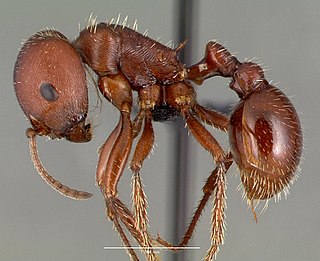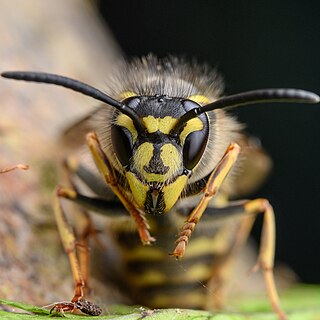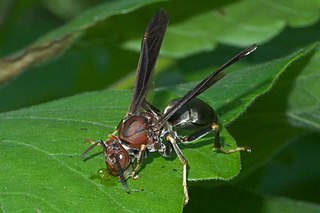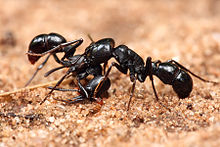
In biology, a colony is composed of two or more conspecific individuals living in close association with, or connected to, one another. This association is usually for mutual benefit such as stronger defense or the ability to attack bigger prey.

Formica rufa, also known as the red wood ant, southern wood ant, or horse ant, is a boreal member of the Formica rufa group of ants, and is the type species for that group, being described already by Linneaus. It is native to Eurasia, with a recorded distribution stretching from the middle of Scandinavia to the northern Iberia and Anatolia, and from Great Britain to Lake Baikal, with unconfirmed reportings of it also to the Russian Far East. There are claims that it can be found in North America, but this is not confirmed in specialised literature, and no recent publication where North American wood ants are listed mentions it as present, while records from North America are all listed as dubious or unconfirmed in a record compilation. Workers head and thorax are colored red and the abdomen brownish-black, usually with a dorsal dark patches on the head and promensonotum, although some individuals may be more uniform reddish and even have some red on the part of the gastern facing the body. In order to separate them from closely related species, specimens needs to be inspected under magnification, where difference in hairyness are among the telling characteristics, with Formica rufa being more hairy than per example Formica polyctena but less hairy than Formica lugubris. Workers are polymorphic, measuring 4.5–9 mm in length. They have large mandibles, and like many other ant species, they are able to spray formic acid from their abdomens as a defence. Formic acid was first extracted in 1671 by the English naturalist John Ray by distilling a large number of crushed ants of this species. These ants primarily eat honeydew from aphids. Some groups form large networks of connected nests with multiple queen colonies, while others have single-queen colonies.

An ant colony is a population of a single ant species able to maintain its complete lifecycle. Ant colonies are eusocial, communal, and efficiently organized and are very much like those found in other social Hymenoptera, though the various groups of these developed sociality independently through convergent evolution. The typical colony consists of one or more egg-laying queens, numerous sterile females and, seasonally, many winged sexual males and females. In order to establish new colonies, ants undertake flights that occur at species-characteristic times of the day. Swarms of the winged sexuals depart the nest in search of other nests. The males die shortly thereafter, along with most of the females. A small percentage of the females survive to initiate new nests.

Pogonomyrmex barbatus is a species of harvester ant from the genus Pogonomyrmex. Its common names include red ant and red harvester ant. These large ants prefer arid chaparral habitats and are native to the Southwestern United States. Nests are made underground in exposed areas. Their diets consist primarily of seeds, and they consequently participate in myrmecochory, an ant-plant interaction through which the ants gain nutrients and the plants benefit through seed dispersal. Red harvester ants are often mistaken for fire ants, but are not closely related to any fire ant species, native or introduced.

The pharaoh ant is a small (2 mm) yellow or light brown, almost transparent ant notorious for being a major indoor nuisance pest, especially in hospitals. A cryptogenic species, it has now been introduced to virtually every area of the world, including Europe, the Americas, Australasia and Southeast Asia. It is a major pest in the United States, Australia, and Europe.

The name army ant (or legionary ant or marabunta) is applied to over 200 ant species in different lineages. Because of their aggressive predatory foraging groups, known as "raids", a huge number of ants forage simultaneously over a limited area.

Tapinoma sessile is a species of small ant that goes by the common names odorous house ant, sugar ant, stink ant, and coconut ant. Their colonies are polydomous and polygynous. Like many social insects, T. sessile employs complex foraging strategies, allocates food depending on environmental conditions, and engages in competition with other insects.

The dwarf honey bee, Apis florea, is one of two species of small, wild honey bees of southern and southeastern Asia. It has a much wider distribution than its sister species, Apis andreniformis. First identified in the late 18th century, Apis florea is unique for its morphology, foraging behavior and defensive mechanisms like making a piping noise. Apis florea have open nests and small colonies, which makes them more susceptible to predation than cavity nesters with large numbers of defensive workers. These honey bees are important pollinators and therefore commodified in countries like Cambodia.

Vespula vulgaris, known as the Common wasp, is a species found in regions that include the United Kingdom, Ireland, Germany, India, China, New Zealand and Australia. It is sometimes known in English as the European wasp, but the same name is used for the species Vespula germanica or German wasp. In 2010, the ostensible Vespula vulgaris wasps in North America were found to be a different species, Vespula alascensis.

Formica sanguinea, or blood-red ant, is a species of facultative slave-maker ant in the genus Formica characterized by the ability to secrete formic acid. It ranges from Central and Northern Europe through Russia to Japan, China, the Korean Peninsula, Africa and also the United States. This species is coloured red and black with workers up to 7 mm long.

Eusociality, the highest level of organization of sociality, is defined by the following characteristics: cooperative brood care, overlapping generations within a colony of adults, and a division of labor into reproductive and non-reproductive groups. The division of labor creates specialized behavioral groups within an animal society which are sometimes referred to as 'castes'. Eusociality is distinguished from all other social systems because individuals of at least one caste usually lose the ability to perform at least one behavior characteristic of individuals in another caste. Eusocial colonies can be viewed as superorganisms.

Polistes metricus is a wasp native to North America. In the United States, it ranges throughout the southern Midwest, the South, and as far northeast as New York, but has recently been spotted in southwest Ontario. A single female specimen has also been reported from Dryden, Maine. Polistes metricus is dark colored, with yellow tarsi and black tibia. Nests of Polistes metricus can be found attached to the sides of buildings, trees, and shrubbery.

Within the insect order Hymenoptera, the Halictinae are the largest, most diverse, and most recently diverged of the four halictid subfamilies. They comprise over 2400 bee species belonging to the five taxonomic tribes Augochlorini, Thrinchostomini, Caenohalictini, Sphecodini, and Halictini, which some entomologists alternatively organize into the two tribes Augochlorini and Halictini.

Formica truncorum is a species of wood ant from the genus Formica. It is distributed across a variety of locations worldwide, including central Europe and Japan. Workers can range from 3.5 to 9.0mm and are uniquely characterized by small hairs covering their entire bodies. Like all other ants, F. truncorum is eusocial and demonstrates many cooperative behaviors that are unique to its order. Colonies are either monogynous, with one queen, or polygynous, with many queens, and these two types of colonies differ in many characteristics.

An ergatoid is a permanently wingless reproductive adult ant or termite. The similar but somewhat ambiguous term ergatogyne refers to any intermediate form between workers and standard gynes. Ergatoid queens are distinct from other ergatogyne individuals in that they are morphologically consistent within a species and are always capable of mating, whereas inter caste individuals, another class of ergatogynes, often are not. Ergatoids can exhibit wide morphological differences between species, sometimes appearing almost identical to normal workers and other times being quite distinct from both workers and standard queens. In addition to morphological features, ergatoids among different species can exhibit a wide range of behaviors, with some ergatoids acting only as reproductives and others actively foraging. Ergatoid queens have developed among a large number of ant species, and their presence within colonies can often provide clues on the social structures of colonies and as to how new colonies are founded. Without wings, almost all species of ants that solely produce ergatoid queens establish new colonies by fission.

Polistes versicolor, also known as the variegated paper wasp or yellow paper wasp, is a subtropical social wasp within Polistes, the most common genus of paper wasp. It is the most widely distributed of South American wasp species and is particularly common in the Southeastern Brazilian states. This social wasp is commonly referred to as the yellow paper wasp due to the distinct yellow bands found on its thorax and abdomen. The P. versicolor nest, made of chewed vegetable fiber, is typically a single, uncovered comb attached to the substrate by a single petiole. The yellow wasp is frequently found in urban areas. New nests and colonies are usually founded by an association of females, sometimes in human buildings.

Mischocyttarus mexicanus cubicola is a neotropical subspecies of paper wasp found in the New World. It is a social wasp that demonstrates two different types of nesting strategies, depending upon context. This context-dependent trait makes Mischocyttarus mexicanus cubicola a good model to study social biology within social wasps. In detail, this trait allows for the females of this species to form nests both individually and as co-founders with other females within the same colony. This subspecies is also known to exhibit cannibalism, with M. m. cubicola queens feeding on their own larvae for nourishment when unaided by workers.

Temnothorax rugatulus is a species of ant in the genus Temnothorax. It is found in North America. More specifically, it is found in the forests of the western United States. Colonies are either monogynous or polygynous. Queens in monogynous colonies are generally larger (marcogynes), about twice the size of conspecific workers; polygynous colonies have smaller queens (microgynes), typically slightly smaller than the workers. T. rugatulus ants are a subdominant ant group.
This is a glossary of terms used in the descriptions of ants.

Plebeia remota is a species of stingless bee that is in the family Apidae and tribe Meliponini. Bees of the species are normally found in a few states in southern Brazil and their nests can be found in tree cavities. Depending on the region, P. remota may have a different morphology and exhibit different behaviors. The bee's diet consists of nectar and pollen that are collected intensely from a few sources. Researchers have conducted a multitude of studies analyzing the changes that occur in the colony during reproductive diapause and what happens during the provisioning and oviposition process or POP.




















